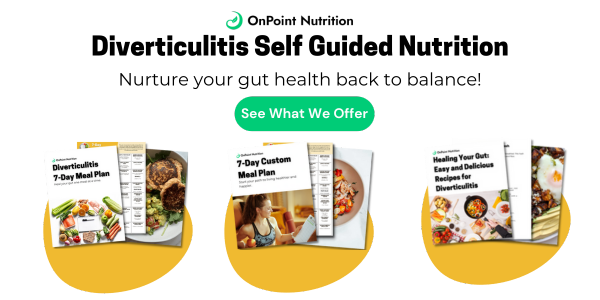
Back
BRAT Diet for Diverticulitis

Whether you learn best with one-on-one support or in a small group setting, we have the perfect program for you.
We also offer a wide array of self-guided materials, empowering you with valuable resources to further support your transformation.
How Nutrition Coaching Works
Our programs are meticulously designed to help you achieve your health goals while enhancing your overall well-being.
We provide personalized counseling and unwavering guidance, ensuring that every step of your journey is met with success.
Take Our QuizOnPoint's team of highly skilled online dietitians and nutritionists are dedicated to empowering you with the knowledge and tools to cultivate sustainable habits that lead to long-lasting success on your health and wellness journey.

Diverticulosis is a condition in which small, bulging pouches develop in your intestines. When these pouches become inflamed, the condition becomes Diverticulitis. The BRAT diet is part of a two-phase diet used to treat a Diverticulitis flare. Phase one of the protocol permits only clear liquids. Once symptoms start improving, you move onto phase two: the BRAT Diet.
BRAT is an acronym for the foods traditionally “allowed” on this diet- Bananas, Rice, Apples, and Toast. The BRAT Diet was developed to include foods that are bland enough to not further disrupt a Diverticulitis flare or exacerbate present symptoms.
However, due to its restrictive nature and lack of nutrient density, BRAT Diet foods have been liberalized significantly. The BRAT Diet now includes a broad range of foods.
Traditionally, the BRAT diet only included bananas, rice, apples and toast. Researchers realized that this diet was too restrictive and did not provide people with the proper nutrition needed to help heal their gut. The foods included in the BRAT diet now are listed below:
Soft fruits: bananas, applesauce, pumpkin, canned fruit packed in water, and melons
Steamed, boiled or canned vegetables: carrots, green beans, potatoes, and squash
Low fiber starches: White bread, white rice, saltine crackers, cream of wheat, boiled noodles
Unseasoned skinless lean proteins: chicken, turkey, scrambled eggs, yogurt, kefir
Drinks: bone broth, apple juice, coconut water, Pedialyte, tea, water
Although the BRAT diet has been liberalized significantly since its conception, it is still relatively restrictive. The foods to avoid on the BRAT diet are listed below:
Milk and dairy products: all except kefir and yogurt
High-fat foods: fast food, fried food, high-fat meats
Spicy foods
Raw vegetables: parsnips, beets, sauerkraut, corn on the cobb, cabbage, broccoli, cauliflower, onions
Citrus fruits: pineapples, oranges, grapefruit, lemons, limes
Other fruits to avoid: cherries, grapes, figs, raisins, and seeded berries
Extremely hot or cold beverages
Alcohol
Caffeine
Added sugars: candy, soda, most juice

Use the below sequence to relieve your diverticulitis symptoms.
First 5-6 hours:
Begin with hard candy or popsicles and progress to ice chips and sips of water.
First 24 hours:
Gradually add clear liquids such as water, 100% apple juice, Pedialyte and Jell-O.
Day Two:
Begin to include foods from the BRAT diet list in small portions every few hours. Start with bland, low-fat foods such as bananas, rice, applesauce, crackers, cooked cereals, toast and jam, yogurt, cooked carrots, chicken and turkey.
Day Three:
Continue with small meals every few hours, sticking to mostly foods from the BRAT-approved list. Gradually add foods from your regular diet over the next few days and monitor for symptoms. If you begin to feel worse, stick to BRAT-approved foods until symptoms subside and then begin liberalizing again.
Following the BRAT diet may help to relieve your diverticulitis flare and help you return to a normal routine.

Kaitlyn Willwerth is a Registered Dietitian at OnPoint Nutrition. Kaitlyn's work focuses on providing individualized health and lifestyle coaching and, most importantly, support. She is a Certified LEAP Therapist and has also completed the Monash University 'Low FODMAP Diet for IBS' online training course for health professionals.
With so many rigid diets and information about quick fixes on how to look and feel great, it can be hard to find which program is right for you. At OnPoint Nutrition, our personalized programs offers one-on-one coaching from a qualified team of dietitians and nutritionists to help you reach your health goals.